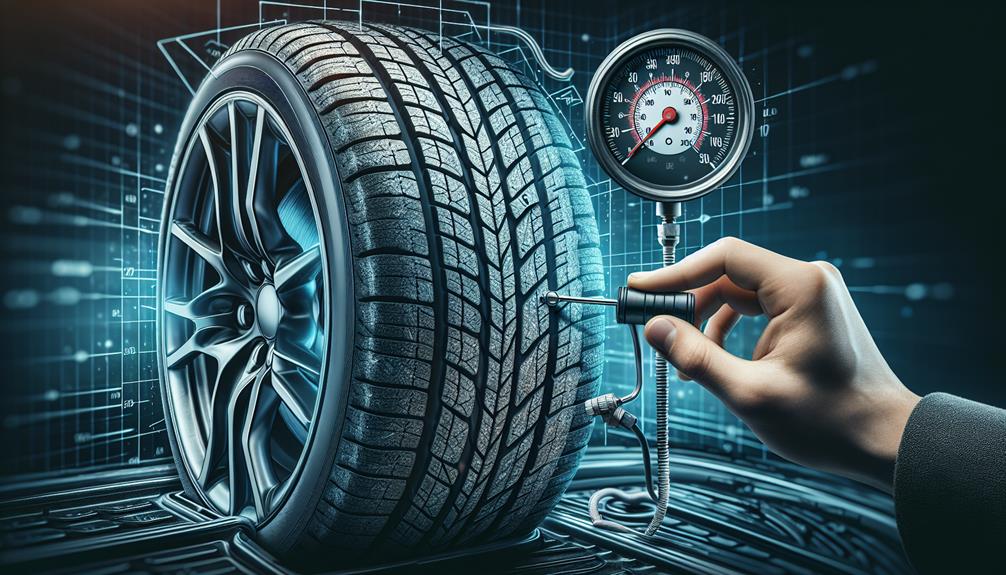So, you're driving down the road and suddenly you hear a loud pop. You pull over to the side and discover that you have a flat tire.
Now what? Well, fear not, because in this step-by-step DIY tire replacement guide, we've got you covered. We'll walk you through the process of safely replacing your tire, from gathering the necessary tools to properly installing the new tire.
But that's not all – we'll also provide you with tips on tire maintenance to ensure that you're always prepared for unexpected situations on the road.
So, let's get started and get you back on the road in no time.
Key Takeaways
- Safety precautions are essential when replacing a tire, including wearing safety goggles and gloves, working in a well-lit area, and being cautious of hot surfaces and moving parts of the vehicle.
- Gathering the necessary tools, such as a jack, jack stands, lug wrench, wheel chocks, and considering the right tire size, is important for a successful tire replacement.
- Properly removing the old tire involves positioning the jack correctly, loosening and removing the lug nuts, and carefully pulling the old tire straight towards you.
- Responsible disposal of the old tire is crucial to protect the environment, and options such as local tire disposal services or recycling should be researched and utilized.
Safety Precautions
To ensure your safety during the tire replacement process, it's imperative to follow these essential precautions.
First and foremost, make sure you have the necessary safety equipment at hand. This includes safety goggles to protect your eyes from any debris or chemicals that may be present during the replacement process. Additionally, wearing gloves will provide you with a better grip and protect your hands from any sharp objects or chemicals.
When it comes to choosing the right tires for your vehicle, it's important to opt for recommended tire brands. These brands have been tested and trusted by experts in the industry, ensuring that they meet the highest standards of safety and performance. By using recommended tire brands, you can have peace of mind knowing that you're driving on reliable and durable tires.
Gathering the Necessary Tools
Before you begin replacing your tires, it's crucial to gather all the necessary tools for a smooth and efficient process. Having the right tools won't only save you time but will also ensure that the tire replacement is done correctly. Here are the tools you'll need:
- Jack and jack stands: These are essential for lifting the car off the ground and providing stability during the tire replacement process. Make sure to choose a jack that can support the weight of your vehicle.
- Lug wrench: This tool is used to loosen and tighten the lug nuts that hold the tire in place. It's important to use the correct size lug wrench to avoid damaging the nuts.
- Wheel chocks: These are small wedges that prevent the car from rolling while you're working on it. Placing them on the opposite side of the tire being replaced will provide additional safety.
When gathering the necessary tools, it's also important to consider choosing the right tire for your vehicle. Understanding tire sizes is crucial in ensuring that you select the correct tire that fits your car's specifications. The size of the tire is usually indicated on the sidewall and includes information such as width, aspect ratio, and rim diameter. Following the manufacturer's recommendations will help you choose the right tire for optimal performance and safety.
Removing the Old Tire
To remove the old tire, securely position the jack under the designated jacking point of your vehicle. This will ensure a stable and safe lifting position. Once the jack is properly in place, use the jack handle or wrench to raise the vehicle until the old tire is off the ground. Make sure to consult your vehicle's owner manual for the recommended jacking points.
With the vehicle lifted, it's time to remove the lug nuts. Use a lug wrench to loosen each nut counterclockwise, but don't remove them just yet. Keep in mind that lug nuts can be tight, so you may need to exert some force.
To help keep track of the lug nuts and their corresponding positions, it's a good idea to create a simple table like the one below:
| Position | Front Left | Front Right | Rear Left | Rear Right |
|---|---|---|---|---|
| Lug Nut #1 | ||||
| Lug Nut #2 | ||||
| Lug Nut #3 | ||||
| Lug Nut #4 |
Remember to loosen the lug nuts in a star pattern to ensure even pressure distribution.
Once the lug nuts are loosened, it's time to remove them completely. Place them in a safe location to avoid misplacing them. Now, you can carefully remove the old tire by gripping it firmly and pulling it straight towards you.
Before moving on to the next step, it's important to consider the proper disposal of the old tire. Improper tire disposal can harm the environment, so be sure to research local tire disposal options. Alternatively, many professional tire replacement services offer tire disposal as part of their service.
With the old tire removed, you're now ready to move on to the next step: installing the new tire.
Installing the New Tire
Now that you have successfully removed the old tire, it's time to proceed with the installation of the new tire. Follow these steps to ensure a safe and proper installation:
- Balancing the new tire:
- Before mounting the new tire onto the wheel, it's crucial to balance it properly. Balancing helps distribute the weight evenly, minimizing vibrations and improving overall performance.
- To balance the tire, take it to a professional tire shop or use a tire balancer machine. They'll attach small weights to the rim to achieve balance. This step is essential to prevent uneven wear and maintain a smooth ride.
- Checking tire pressure:
- Once the new tire is mounted and balanced, it's important to check the tire pressure before hitting the road. Proper tire pressure ensures optimal handling, fuel efficiency, and tire lifespan.
- Use a tire pressure gauge to measure the pressure. Refer to your vehicle's manual or the tire manufacturer's recommendations for the correct pressure. Inflate or deflate the tire as necessary to reach the desired pressure.
Proper Tire Maintenance
For optimal performance and longevity of your tires, it's essential to adhere to proper tire maintenance practices. Two crucial aspects of tire maintenance are tire rotation and tire pressure monitoring.
Regular tire rotation is necessary to ensure even wear on all four tires. By rotating the tires, you redistribute the weight and promote uniform tread wear. This helps extend the life of your tires and improves overall performance. It's recommended to rotate your tires every 5,000 to 8,000 miles or as specified by your vehicle's manufacturer.
Additionally, monitoring tire pressure is vital for both safety and performance. Underinflated or overinflated tires can lead to decreased fuel efficiency, poor handling, and increased risk of a blowout. You should check your tire pressure at least once a month using a tire pressure gauge. Make sure to inflate the tires to the recommended PSI (pounds per square inch) as specified in your vehicle's owner manual or on the tire placard.
Frequently Asked Questions
How Often Should I Replace My Car Tires?
You should replace your car tires regularly to ensure optimal performance and safety. Look out for signs of tire wear, such as low tread depth or cracking. Choose the right tire for your car based on your driving needs and manufacturer recommendations.
Can I Use a Different Size Tire on My Car?
Yes, you can use a different size tire on your car, but it may have an impact on the performance and safety. Alternative tire sizes can affect the speedometer accuracy, handling, and overall vehicle dynamics.
Is It Necessary to Balance the New Tire After Installation?
After installing a new tire, it is necessary to balance it to ensure proper tire alignment. Failing to do so can lead to uneven wear, reduced performance, and potential safety hazards. Avoid these common mistakes for a smooth tire replacement process.
What Is the Recommended Tire Pressure for My Car?
You should regularly check your tire pressure to ensure optimal performance. Proper tire pressure affects fuel efficiency, as underinflated tires can increase resistance and decrease mileage. It's important to maintain the recommended tire pressure for your car.
How Can I Check the Tread Depth of My Tires?
To check the tread depth of your tires, look for the tire tread wear indicators. These are small bars that run across the tire grooves. If the tread is level with these bars, it's time to replace the tires.
Conclusion
In conclusion, following this step-by-step DIY tire replacement guide will enable car owners to safely and effectively replace their tires. By adhering to the safety precautions and utilizing the necessary tools, removing and installing the tires becomes a straightforward process.
Proper tire maintenance is essential to ensure optimal performance and longevity. For example, a case study of a car owner who regularly checks tire pressure and rotation schedules experienced improved fuel efficiency and reduced tire wear, resulting in cost savings and increased safety on the road.
- How to Close Spark Plug Gap: Expert Tips and Tricks! - May 13, 2024
- How to Perfectly Align Projector Headlights With Halo - May 13, 2024
- How Many Amps Does a Car Horn Draw? Unveiling the Power Requirements - May 13, 2024



